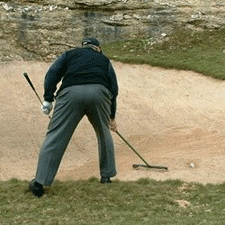Every year the HealthONE Colorado Open presents challenging situations to some of the state’s best players. And while Green Valley Ranch is known for it’s ESA’s, there are plenty of hazards and ill-placed bunkers to wreak havoc on a players ball and scorecard. There are specific actions in hazards that are prohibited by the Rules of Golf, and as one player learned earlier this year, not knowing these can help those hazards do even more damage on a scorecard.
On the 14th hole at Green Valley Ranch, a reachable par four with long native rough lining the right side, a player and his fellow-competitors walked through a greenside bunker to look for an errant tee shot right of the green. In doing so, they created a lot of foot prints and generally made a mess of the bunker. One player’s ball was in that bunker, near the front of the green in a position where the footprints would not affect his line of play towards the flag. However, before the player hit his shot, he decided to rake the bunker as a courtesy to the next group to play the hole. After completion of the hole, the group approached a rules official and inquired if there was a breach of the rules when the bunker was raked. The answer was “yes”– the player’s actions violated Rule 13-4 and he was assessed a two-stroke penalty.
Rule 13-4 covers actions that are prohibited while a ball is in a hazard. Specifically, the rule states that “…before making a stroke at a ball that is in a hazard (whether a bunker or a water hazar…the player must not:
a. test the condition of the hazard or any similar hazard
b. touch the ground in the hazard or water in the water hazard with his hand or a club
c. touch or move a loose impediment lying in or touching the hazard
In the case illustrated above, the player incurred a two-stroke penalty for testing the condition of the bunker before he had made a stroke at his ball in that bunker. Decision (13-4/0.5) better defines, and offers very clear examples of, what is and what is not considered “testing the condition” of the hazard. For example, some common actions that will cost player two strokes include: smoothing a bunker with a rake, kicking the ground in the hazard, or touching the sand with a club when making a practice swing or otherwise. Clearly, by raking the bunker before his shot, the player was in violation of the rule. Please note, one of the other players in the group could have raked the bunker and no penalty would have been assessed to anyone.
Not everything is off-limits in a hazard–there are some fairly common actions in a hazard that can occur without being penalized. These include: placing an object such as clubs in the hazard, leaning on an object other than a club (such as a rake) while it is touching the ground in a hazard, and marking the position of the ball with a tee or otherwise when proceeding under a Rule.
Obviously, hazards such as bunkers are designed to punish errant or risky shots and ultimately add strokes to your score. Not knowing the Rules when your ball is in a hazard only helps their cause!


